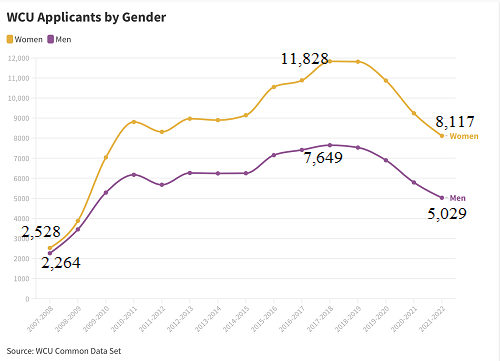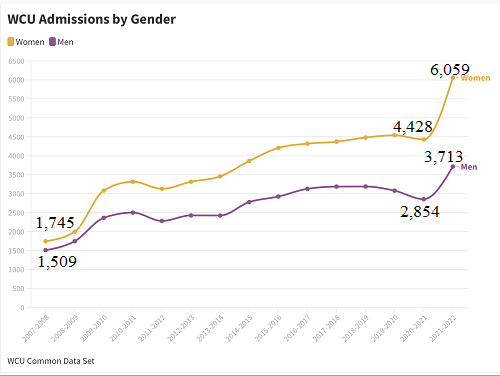Today, if you visit almost any college campus, you might notice a curious gender imbalance: about six women attend for every four men, making it the largest gender gap in higher education history. This phenomenon reveals a shift in attitude among men as they disengage from education, the economy, and society.
But does this gender disparity apply to WCU?
In short, yes. Male students are in short supply at WCU. We’re like the rest of the country, where, on average, only 41% of college students are males. The Fall 2022 census, for example, shows female students make up 58% of the student body in Cullowhee — male students: 42%.
This phenomenon may seem surprising, but it’s hardly breaking news, considering it took effect about 40 years ago. In 1970, men made up 57% of college and university students. Then, two years later, Congress passed Title IX rules curbing sex-based discrimination in schools receiving federal funding. Females subsequently enrolled in higher education more often — males didn’t. Now, the gender gap in pursuing a four-year degree in the U.S. is larger than when Congress passed this law to promote equal education — but the other way around.
Many are concerned this gender imbalance will diminish campus diversity and the college experience. To counteract this, some colleges have quietly given male applicants an edge in admissions — sparking heated debates surrounding gender-based affirmative action and favoring a privileged group. This piece won’t dive deep into the philosophical arguments of this topic. But, to explain one of the most significant happenings of our time, we need to look at numbers.
To begin, it’s helpful to understand why American males are disengaging from higher education. Brookings Fellow Richard V. Reeves sheds light on this issue, in part, at least, in his new book “Of Boys and Men.” According to Reeves, the U.S. education gender gap starts long before college. Beginning in elementary school, girls outperform boys. As research indicates, they spend more time studying, are less likely to have disciplinary problems, and get better grades in all major subjects. This trend is a ripple effect, increasing over time, which is why females earn higher GPAs in high school and graduate at disproportionately higher rates. As a result, boys are less qualified on average, which partially explains why men are the minority in higher education.
Even so, cultural critics have largely ignored this trend for decades. The Covid-19 pandemic, however, made the situation increasingly severe, and conversations about it are returning. To give you an idea: The Wall Street Journal reported that about 70% of the decline in college enrollment during Covid-19 was attributed to males.
WCU saw a sharp decline in male and female applicants due to the pandemic. These numbers are still falling, and the gender disparity widens as many men hold off on applying. Last year’s admissions cycle was particularly impressive, where female applicants exceeded male applicants by an enormous 35% nationwide. This divergence was even greater at WCU: roughly 47%. Truthfully, men show no sign of bridging that gap.

The world is changing as the concept of masculinity struggles to keep up. But make no mistake: men continue to dominate positions of special status. They still make up the overwhelming majority of CEOs and politicians, despite being, for decades now, the minority in higher education. The men who achieve positions of prominence and power are, in fact, beneficiaries of the patriarchy. However, men, as a whole, are doing poorly compared to women. And while they are more likely to attend college now than ten years ago, something seems to be limiting their enrollment growth.
Women, on the other hand, have encountered obstacles preventing them from catching up to men for years. To their advantage, they’re starting to overcome these barriers and, in some respects, are even starting to surpass men. That’s certainly true of higher education, where there’s no denying that many men are losing. But the rise of one gender shouldn’t determine the fall of the other. It’s not like women are inhibiting men’s success just because they’re starting to do well — it’s not a zero-sum game. That said, if men stop getting educated, it becomes more difficult for them on the labor market; then — and these factors are all connected — it becomes more difficult for them in family life too.
The gender gap in higher education shows no sign of narrowing. So, from there, what should WCU do? To that question, I have no conclusive answers. However, I can throw out some ideas.
The rate of acceptance at WCU is equal for men and women. The admissions team should keep it that way. Co-ed institutions — like WCU — aim to maintain a 1:1 female-male ratio. Attaining gender parity, however, shouldn’t come at the cost of barring more women from admission because they’re playing the game and playing it well.

Remember, college isn’t for everyone, and many men willingly opt out because they want to enter other fields of work — mainly ones in blue-collar economics, like trades.
Still, many boys are dissuaded and left behind in their early years. So, by the time they reach early adulthood, continuing education no longer feels worth it. Solving this problem requires a policy change on the national level. Of course, it’s outside the purview of a university to alter American social policy, but the administration of a school like WCU can take steps beyond admissions. Since men are less engaged, they need to consider how each gender approaches higher education differently and adjust to that. In college, men are less likely to participate in extracurriculars like clubs and organizations, hold student government positions, and study abroad. Plus, they also take longer to graduate on average.
So, until changes are made, more people need to think about the future of higher education, what it holds, and who’s a part of it.






